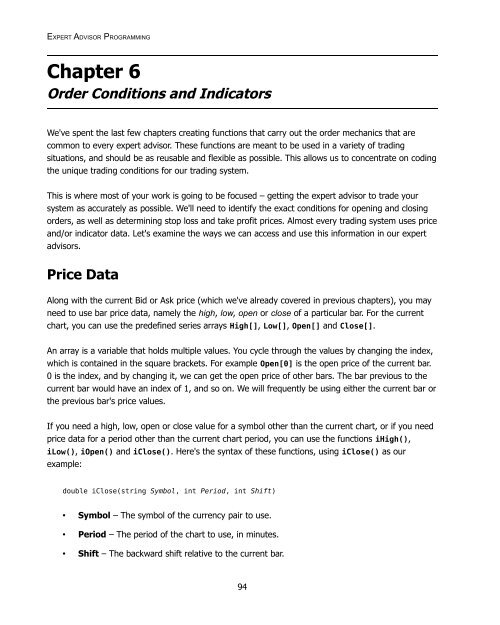Expert Advisor Programming by Andrew R. Young
Expert Advisor Programming by Andrew R. Young
Expert Advisor Programming by Andrew R. Young
Create successful ePaper yourself
Turn your PDF publications into a flip-book with our unique Google optimized e-Paper software.
EXPERT ADVISOR PROGRAMMING<br />
Chapter 6<br />
Order Conditions and Indicators<br />
We've spent the last few chapters creating functions that carry out the order mechanics that are<br />
common to every expert advisor. These functions are meant to be used in a variety of trading<br />
situations, and should be as reusable and flexible as possible. This allows us to concentrate on coding<br />
the unique trading conditions for our trading system.<br />
This is where most of your work is going to be focused – getting the expert advisor to trade your<br />
system as accurately as possible. We'll need to identify the exact conditions for opening and closing<br />
orders, as well as determining stop loss and take profit prices. Almost every trading system uses price<br />
and/or indicator data. Let's examine the ways we can access and use this information in our expert<br />
advisors.<br />
Price Data<br />
Along with the current Bid or Ask price (which we've already covered in previous chapters), you may<br />
need to use bar price data, namely the high, low, open or close of a particular bar. For the current<br />
chart, you can use the predefined series arrays High[], Low[], Open[] and Close[].<br />
An array is a variable that holds multiple values. You cycle through the values <strong>by</strong> changing the index,<br />
which is contained in the square brackets. For example Open[0] is the open price of the current bar.<br />
0 is the index, and <strong>by</strong> changing it, we can get the open price of other bars. The bar previous to the<br />
current bar would have an index of 1, and so on. We will frequently be using either the current bar or<br />
the previous bar's price values.<br />
If you need a high, low, open or close value for a symbol other than the current chart, or if you need<br />
price data for a period other than the current chart period, you can use the functions iHigh(),<br />
iLow(), iOpen() and iClose(). Here's the syntax of these functions, using iClose() as our<br />
example:<br />
double iClose(string Symbol, int Period, int Shift)<br />
• Symbol – The symbol of the currency pair to use.<br />
• Period – The period of the chart to use, in minutes.<br />
• Shift – The backward shift relative to the current bar.<br />
94
















